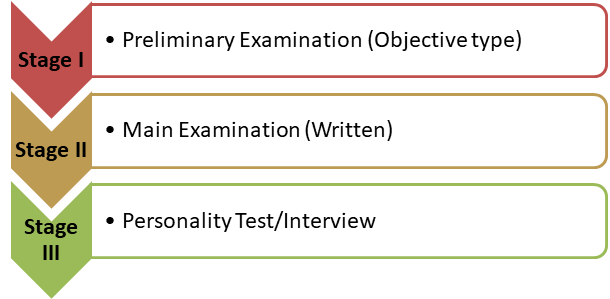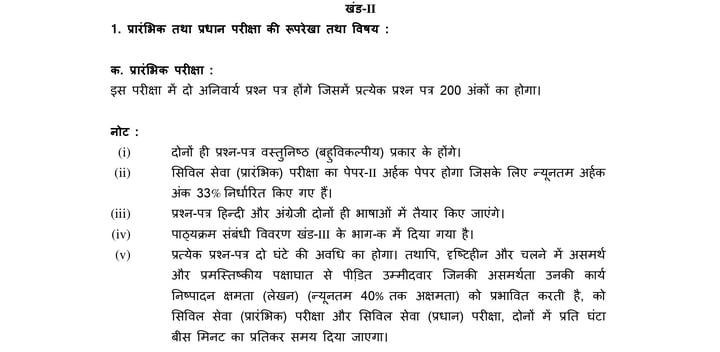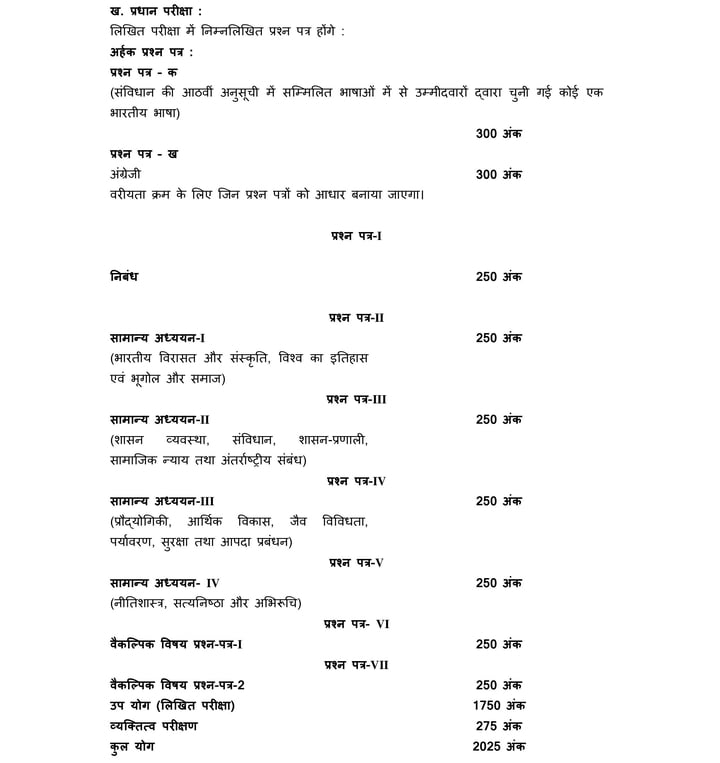UPSC Exam Pattern 2023 – IAS Prelims, Mains, CSE Paper Pattern PDF, Total Marks
By BYJU'S Exam Prep
Updated on: November 14th, 2023
UPSC Exam Pattern is released by Union Public Service Commission (UPSC) to test the academic expertise of a candidate and also their ability to present the answers in a coherent manner. That is why the aspirants must comprehensively understand the UPSC exam pattern for both Prelims and Mains. A complete understanding of the exam pattern would help the candidates manage their time and make their preparation more efficient. Additionally, it will be easier to align their preparation with the exam needs. The UPSC exam pattern will enable the candidates in deciphering a clear picture of the number of questions and negative markings.
The UPSC exam is conducted in three phases, i.e. Prelims Exam, Mains Exam, and Personality Test. Below mentioned is the detailed UPSC exam pattern for all the stages, along with complete information on negative markings. A complete knowledge of the UPSC exam pattern can take the candidates in the right direction for the exam.
Table of content
-
1.
UPSC Exam Pattern
-
2.
IAS Exam Pattern PDF
-
3.
UPSC Prelims Exam Pattern
-
4.
Negative Marking in UPSC
-
5.
UPSC Mains Exam Pattern
-
6.
UPSC Mains Marks Distribution
-
7.
UPSC Exam Pattern for Optional Subjects
-
8.
UPSC Exam Pattern for Interview
-
9.
Changes in UPSC Paper Pattern
-
10.
UPSC Exam Pattern in Hindi
-
11.
UPSC Exam Pattern for IPS
-
12.
UPSC Exam Pattern vs UPSC EPFO Exam Pattern
UPSC Exam Pattern
The selection process for UPSC Exam divides the IAS Exam Pattern into three stages. Candidates must clear each stage to move on to the next one. The Prelims exam 2023 is scheduled for 28th May 2023, the candidates who will crack the exam will be shortlisted for the Mains exam. Aspirants who qualify for the Mains exam will be called for the Personality test round.

UPSC Paper Pattern 2023
As the cycle of the IAS Exam is year-long, it is important to have a fair understanding of the complete UPSC Exam pattern for prelims, mains, and interviews. The candidates can get the complete details of the UPSC pattern as listed here.
| UPSC Exam Stages | Number of Papers | Total Marks | Nature of the Exam |
| UPSC Prelims Exam Pattern | 2 Papers – GS Paper 1 & CSAT | 400 | Objective Type |
| UPSC Mains Exam Pattern | 9 Papers | 1750 | Descriptive Test |
| IAS Interview | – | 275 | Personality Test |
| UPSC Total Marks | Mains Marks + Interview Marks = 2025 Marks | ||
IAS Exam Pattern PDF
Candidates must take a strategic approach to prepare according to the exam pattern of UPSC to limit the negative marking in the prelims exam and answer the maximum number of questions in the Mains Exam. The candidates need to present a well-prepared UPSC preparation strategy in order to perform exceptionally in the exam.
UPSC Exam Pattern PDF
The UPSC Exam Pattern in Hindi and English remains the same in terms of the number of questions, total marks, and negative markings. The illustration of the exam pattern has been elaborated here.

UPSC Prelims Exam Pattern
The UPSC exam pattern for Prelims comprises two papers, namely General Studies-1 and General Studies-2 (also known as CSAT). Both the papers of the prelims exam are held in one day.
- UPSC Prelims GS Paper 2 / CSAT Paper is a qualifying paper.
- Candidates must score at least 33% in the CSAT exam to qualify. Understand the UPSC CSAT Syllabus to ensure you clear the paper on the first attempt.
Candidates must remember that the Prelims exam is conducted to filter the candidates for the Mains exam, and marks secured in this exam won’t be counted in the final merit list. The cutoff marks for Prelims are calculated only based on paper 1. Along with the prelims exam pattern, aspirants must also check UPSC Prelims Syllabus.
- As per the UPSC prelims exam pattern, candidates will be given 2 hours of time for each paper.
- GS-1 will have a total of 100 questions, and GS-2 carries 80 questions. The total marks for each paper will be 200 as per the UPSC Prelims marking scheme.
UPSC Marks Distribution for Prelims
One of the most important parts of the prelims paper pattern is negative marking. As prelims is a qualifying exam, there is a negative marking of 1/3 marks for every incorrect answer.
| UPSC Exam Pattern for Prelims | Type | Nature of Paper | No. of questions | UPSC Total Marks | Duration |
| General Studies 1 | Objective | Merit Ranking | 100 | 200 | 2 hours |
| General Studies 2- CSAT | Objective | Qualifying | 80 | 200 | 2 hours |
| UPSC Prelims Total Marks | 400 | ||||
Negative Marking in UPSC
As per the UPSC exam pattern for Prelims, each question of General Studies-1 carries 2 marks, and each question carries 2.5 marks for the CSAT paper.
- There will be a negative marking in UPSC of 1/3 of the mark allotted to that question.
- This means for IAS Prelims Paper 1, there will be a negative marking of 0.66.
- For CSAT, the UPSC negative marking will be 0.83.
| Paper | Number of Questions | UPSC Prelims Total Marks | UPSC Prelims Marking Scheme- Negative Marks |
| General Studies-1 | 100 | 2*100=200 | 0.66 |
| General Studies-2 (CSAT) | 80 | 2.5*80=200 | 0.83 |
UPSC Mains Exam Pattern
UPSC Mains Exam Pattern is different from the prelims pattern as it is a detailed paper. UPSC Mains 2023 is scheduled to be conducted on September 15, 2023. Those who crack the Prelims exam are eligible to appear for the Mains exam. Download the UPSC Mains Syllabus to better understand the topics asked in the exam. As per the UPSC Exam Pattern for Mains, candidates must take two types of papers- Qualifying and Merit Papers.
- There will be a total of 9 papers from which two papers will be qualifying in nature, four for General Studies, and two for the optional subjects.
- Candidates get the freedom to choose an optional subject for the Mains exam.
- Additionally, all the papers will be descriptive.
Check out the complete UPSC Paper Pattern for Mains below in the table.
| UPSC Marking Scheme for Mains | ||||
| Paper | Subject | Nature of Paper | Duration | IAS Total marks |
| Paper A | Compulsory Indian language | Qualifying in Nature (25% i.e.75 marks required) | 3 hours | 300 |
| Paper B | English | 3 hours | 300 | |
| Paper I | Essay | Marks will be counted to determine the Final Merit list. | 3 hours | 250 |
| Paper II | General Studies I | 3 hours | 250 | |
| Paper III | General Studies II | 3 hours | 250 | |
| Paper IV | General Studies III | 3 hours | 250 | |
| Paper V | General Studies IV | 3 hours | 250 | |
| Paper VI | Optional I | 3 hours | 250 | |
| Paper VII | Optional II | 3 hours | 250 | |
| UPSC Mains Total Marks = 1750 | ||||
Paper A is not compulsory for candidates from Meghalaya, Mizoram, Arunachal Pradesh, Sikkim, Manipur, and Nagaland and for those with hearing impairment. However, these candidates must prove they have been exempted from 2nd or 3rd language courses by their university or board. The UPSC mains exam pattern comprises 4 GS Papers; details of each paper have been mentioned below-
- General Studies 1 Syllabus: (Indian Heritage and Culture, History, and Geography of the World and Society)
- General Studies 2 Syllabus: (Governance, Constitution, Polity, Social Justice, and International Relations)
- General Studies 3 Syllabus: Technology, Economic Development, Bio-diversity, Environment, Security and Disaster Management)
- General Studies 4 Syllabus: (Ethics, Integrity, and Aptitude)
UPSC Mains Marks Distribution
As per the UPSC mains exam pattern, papers A and B are qualifying, and all the remaining papers are counted for merit. Candidates must score at least 25% (each paper) to be considered for the final merit list. Paper-A and Paper-B carry 300 marks each. And other seven papers carry a total of 250 marks each.
UPSC Exam Pattern for Optional Subjects
As mentioned earlier, the Mains pattern includes two optional papers. Each paper carries 250 marks in accordance with the UPSC Marking Scheme. Candidates can choose any subject they want from the list of UPSC Optional Subjects. Here is the list of all the optional subjects.
| UPSC Paper Pattern – Optional Subjects | ||||
| Mechanical Engineering | Medical Science | Philosophy | Physics | Political Science and International Relations |
| Civil Engineering | Commerce and Accountancy | Economics | Electrical Engineering | Geography |
| Psychology | Public Administration | Sociology | Statistics | Zoology |
| Agriculture | Animal Husbandry and Veterinary Science | Anthropology | Botany | Chemistry |
| Geology | History | Law | Management | Mathematics |
| The literature of any one of the following languages: Santhali, Sindhi, Tamil, Telugu, Maithili, Assamese, Konkani, Malayalam, Manipuri, Marathi, Nepali, Odia, Punjabi, Sanskrit, Bengali, Bodo, Dogri, Gujarati, Hindi, Kannada, Kashmiri, Urdu, and English. | ||||
UPSC Exam Pattern for Interview
A personality test or IAS Interview is the final round of the exam before the final merit list is declared. Those who manage to clear Mains will get e-summon letters for this final round. As per the UPSC exam pattern, this round consists of interviews with board members of the Union Public Service Commission to judge the candidates for Civil Services careers and associated responsibilities.
Here, the interview panel observes the candidate’s mental and social traits by asking general interest IAS interview questions. Here the members evaluate the logical exposition, balance of judgment, alertness, depth, variety of interest, leadership, ability of social cohesion, and moral integrity.
- UPSC Paper Pattern released by the Commission states that the total marks for the interview round will be 275.
- After the declaration of the UPSC Result of the interview round, the final merit list will be prepared based on marks obtained by the candidate in the Mains and Interview.
Changes in UPSC Paper Pattern
UPSC Exam Pattern has seen few changes over the years. Below we have mentioned the year and changes made in the UPSC exam pattern in that particular year.
- In 2011, the UPSC introduced the CSAT paper in the Civil Services Exam, this was the first change in the UPSC Exam Pattern. CSAT was introduced to check the analytical and decision-making ability of the candidates. The GS-1 and CSAT paper marks were considered for the merit list of the Prelims exam.
- In 2012, UPSC decided to make the IAS syllabus generic and introduced a new UPSC exam pattern. In this pattern, Paper-I and Paper-II optional papers had two sessions, two general studies papers, and one essay paper was included as well. Candidates had to choose two subjects from the optional list.
- In 2013, the UPSC Syllabus went through major changes. UPSC added another General Studies paper called ethics and made one optional subject with two papers.
- In 2014, the Civil Services exam pattern had a few changes. The essay paper of the Mains exam had two topics from each section, but it was changed to 1. Additionally, the number of attempts and age limit for the General category candidates also increased. The number of attempts increased from 4 to 6, and the upper age limit increased from 30 to 32.
- In 2015, UPSC made the CSAT paper qualifying in nature, and the marks scored in GS-1 were considered for the merit list. Candidates needed at least 33% to crack the CSAT paper.
UPSC Exam Pattern in Hindi
हिंदी में यूपीएससी परीक्षा पैटर्न अंग्रेजी में यूपीएससी परीक्षा पैटर्न के समान है। परीक्षा को तीन चरणों में बांटा गया है – प्रारंभिक, मुख्य और साक्षात्कार।
UPSC Prelims Exam Pattern in Hindi

UPSC Mains Exam Pattern in Hindi

UPSC Exam Pattern for IPS
UPSC conducts Civil Services Examination (CSE) to recruit candidates for 24 civil services, including the Indian Police Service IPS. The UPSC exam pattern is the same for all posts of the civil services exam. There will be three stages, Prelims, Mains, and Interviews. After the announcement of CSE results, those who have applied for IPS will become IPS officers depending on their rank.
UPSC Exam Pattern vs UPSC EPFO Exam Pattern
Above, we have mentioned the UPSC exam pattern for Civil Services Exam (CSE), which is different from the UPSC EPFO exam pattern. Union Public Service Commission is responsible for so many exams, and the exam pattern for each exam is not the same. The UPSC EPFO exam pattern covers two stages, the first stage includes carrying objective-type questions, and the second round is the interview. Those who clear the first round will be eligible for the Interview round. The first round carries 300 marks, and the interview round carries 100 marks.
